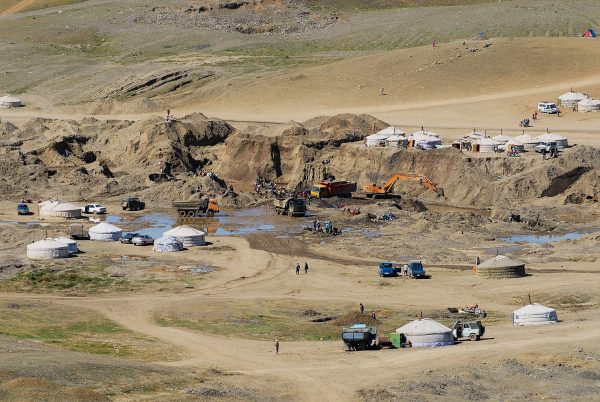
Mongolia is blessed with a wealth of mineral resources, and mining has always been an important part of Mongolia’s economy. However, mining revenues are not allocated wisely; instead of using mineral wealth to reduce its dependence on the extractive sector, Mongolia has become “addicted” to it.
In addition, the industry is plagued by corruption. The Corruption Perceptions Index 2023 by Transparency International ranks Mongolia 116th out of 180 countries. The corporate corruption of state-owned mining companies took society by storm in December 2022. Thousands of Mongolians protested in the freezing cold, demanding the government hold officials accountable for the alleged theft of 385,000 tons of coal.
Basically, Mongolia hasn’t been managing its mineral wealth well. So how can Mongolians address these shortcomings moving forward?
Transparency and accountability initiatives have emerged as a potential solution to combat corruption and increase public benefits from the extractive sector in resource-abundant countries. For example, the Canadian mining industry worked alongside civil society and the government to put Canada in a leadership position in the global transparency movement. Starting in 2012, the Prospectors and Developers Association of Canada (PDAC) has actively advocated for greater transparency in mineral exploration, by disclosing and reporting payments made to any level of government in Canada or overseas. In June 2015, the government of Canada issued the Extractive Sector Transparency Measures Act, which requires mining and oil and gas entities to disclose such payments.
The Extractive Industry Transparency Initiative (EITI) is another initiative designed to combat corruption in the mining industry. Mongolia joined this initiative in September 2007. EITI aims to strengthen resource governance and reverse the “resource curse” through reporting on companies’ payments to governments and governments’ receipt of such payments. Since 2013, information disclosures include licenses and contracts, production and sales, beneficial ownership, and state participation.
Transparency is essential, but there is growing evidence that transparency alone is not sufficient to improve natural resource governance’s social and economic outcomes. To maximize the benefits of these transparency initiatives, a stakeholders engagement process should be in place.
Major international organizations such as the Organization for Economic Cooperation and Development (OECD), the United Nations, the European Union, and the World Bank have stressed the importance of stakeholder engagement as a useful process in promoting dialogue and building relationships.
The International Council on Mining and Metals (ICMM), the global mining industry body, identifies stakeholders’ engagement as one of the key principles for the mining industry to promote sustainable benefits from resource extraction. As a global leadership organization for sustainable development, the ICMM obligates its members to proactively engage with key stakeholders on sustainable development challenges and opportunities in an open and transparent manner. It measures success by contributing to creating “a safe, just and sustainable world through responsibly produced metals and minerals.”
Industry leaders also recognize that the most important piece is engagement with local stakeholders to ensure they are involved in decisions likely to affect them and able to cooperate in achieving sustainable benefits during and after mining. In particular, environment, social, and governance (ESG) targets are essential to increasing societal acceptance of mining.
A recent study on community engagement in mining in Mongolia demonstrates that the majority of mining companies – whether large conglomerates or small enterprises; state-owned or private; foreign or Mongolian owned – do not have community engagement or social responsibility policies in their corporate management policy. There are examples of a few companies that have community engagement programs and social responsibility policies; in such cases, their relationships with local communities are well established, long term, and well maintained. But these are the exceptions, rather than the norm.
The study indicates that a low level of community engagement and lack of transparency of agreements in the mining sector reflects the overall picture of the mining industry in Mongolia. And the environmental performance of mining companies is one of the key indicators of whether the local community has trust in mining companies.
The Intergovernmental Forum on Mining, Minerals and Metals on Sustainable Development (IGF) highlights the importance of consultation and engagement on the social and environmental impacts of mining. It recommends that governments promote stakeholder engagement through government policies as an important part of developing good practices and as a tool for reducing environmental impacts and maximizing benefits to communities.
Stakeholder engagement in mining encompasses several key components such as participatory environmental monitoring, including transparent data communication, and community-based water monitoring that promote trust and building relationships.
Moreover, the stakeholders’ engagement platform provides an opportunity for mining companies to communicate their anti-bribery program and this way increase accountability.
Enhanced transparency through the stakeholders’ engagement process will help to reduce instances of corruption by enabling citizens to participate in the agreement-making process and hold their governments accountable for making better decisions in allocation and spending mining revenues. It will also help to ensure that these revenues contribute to sustainable development for a brighter future for young Mongolians.
So far, a stakeholders’ engagement process in mining is nearly absent (except few mining companies) in Mongolia. The results are clearly seen in recent protests and the Corruption Perception Index. To fix Mongolia’s mining industry – and address the resulting societal discontent – engaging with local communities would be a good place to start.
How to Fix Mongolia’s Mining Industry
Source: Frappler

0 Comments